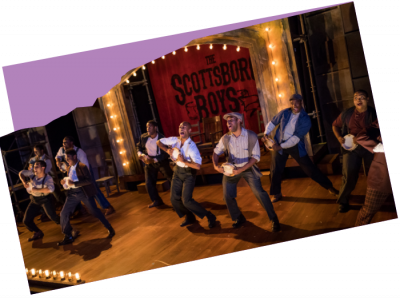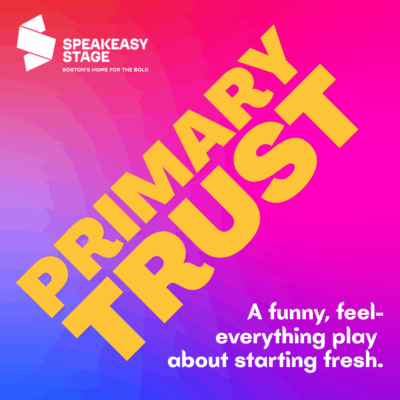Your donation sets the stage for a new season of Boston's most intimate, entertaining and provocative plays and musicals. Our shows make powerful connections with our audiences-- and they are only possible because of you.
Who’s Your Neighbor Now?
Who’s Your Neighbor Now?
Who’s Your Neighbor Now?: Race, Real Estate, and Revisiting A Raisin in the Sun
 By Adrienne Macki Braconi, Assistant Professor, Dramatic Arts Department, Faculty Affiliate, Institute for African American Studies, University of Connecticut
By Adrienne Macki Braconi, Assistant Professor, Dramatic Arts Department, Faculty Affiliate, Institute for African American Studies, University of ConnecticutIn February 2009, CBS news reported that a booth at the GOP’s Republican Convention in Dallas, Texas sold controversial black and white buttons that read, “If Obama is President…will we still call it The White House?” [i] This racial slur alluded to still-lingering anxieties surrounding the fact of racial integration. It placed a spotlight on the intersection of race relations and housing as 1600 Pennsylvania Avenue stood paradoxically as a symbol of freedom, democracy, as well as of black oppression considering that it was built in large part by slave labor and that twelve of the nation’s presidents were involved with slave trade. [ii] Thus, when President Obama and his family moved to the neighborhood in 2009—becoming the White House’s first black residents (not including servants)—it evoked a long history of Jim Crow segregation and “separate but equal” racial codes.
Fifty years before the Obamas settled in to the White House, Lorraine Hansberry’s classic A Raisin in the Sun took Broadway by storm in March 1959. Her compelling family drama offered a timely response to the national controversy around Jim Crow segregation, especially as black families relocated into white communities and schools following such groundbreaking cases as Hansberry v. Lee, 1940 and Brown v. Board of Education of Topeka, Kansas, 1954 (which had overturned Plessy v. Ferguson, 1896’s state-sponsored segregation).
Specifically, Hansberry’s seminal play illustrates the complex relationships between upward mobility and economic control, and freedom and access—to agency, power, and the means to affect change. In it, Lena Younger, a struggling domestic worker, is poised to inherit $10,000 from her late husband’s life insurance policy. She dreams of moving her family of five, who live in a crowded tenement in Chicago’s South Side, to a home of their own while her son, Walter, pins his hopes on opening a liquor store. Overcoming great hostility, the Youngers finally move into the “white” neighborhood of Clybourne Park.
Raisin in the Sun was deemed a critical and commercial success. While not the first play by African American playwright on Broadway, it represented a watershed moment, paving the way for actors, directors, and playwrights of color. Since then, it has been adapted into a musical, Raisin, and into several films. Owing to its enduring relevance and popularity, Hansberry’s play has enjoyed numerous revivals. One of the most notable productions includes its highly acclaimed return to Broadway starring Phylicia Rashad, Sean Combs, and Audra McDonald. The production earned the 2004 Tony award for Best Revival. Our neighbor, the Huntington Theatre in Boston, will also present Hansberry’s play this spring (March 8th-April 7th).
Looking at Raisin in the Sun and Clybourne Park: Creating the Space for Difficult Dialogues
Writing about the premiere of her play, Hansberry explained to her mother:
Mama, it is a play that tells the truth about people. Negroes and life and I think it will help a lot of people to understand how we are just as complicated as they are—and just as mixed up—but above all, that we have among our miserable and downtrodden ranks—people who are the very essence of human dignity. That is what, after all the laughter and tears, the play is supposed to say. [iii]
While Hansberry’s emphasis on truth-telling and laughter is in some ways mirrored in Bruce Norris’s award-winning play, Clybourne Park, he claims that his intention in writing the piece was more to “outrage people.” Norris, who had long admired Hansberry’s script, revealed in an interview that his play was “about the white response to race, about being the power elite, about being the people who have power in the race argument.” [iv]
Moreover, Norris’s imaginative and highly irreverent approach casts a wider net to illuminate prejudice in the broadest terms, whereas Hansberry’s script unveils the fraught intersection of race and real estate by focusing on economic and social issues. Though Norris also highlights the racial politics of real estate, his satirical style, sharp-wit, stereotypical characters, and dramaturgical structure offer a radically different intervention into Hansberry’s canonized text. Nevertheless, he maintains subtle, and not so subtle, gestures that intertwine his work with Hansberry’s, from his inclusion of Lena Younger’s grand niece, Lena, to the preservation of Raisin’s Karl Linder, the Clybourne Park representative who attempts to persuade the Younger family to stay out of the neighborhood. Similarly, the young soldier’s trunk, introduced in Act I and resurrected in Act II, provides a symbolic stage prop that not only binds Norris’s two acts together, but also recalls Mama Younger’s plant in Raisin (presumably planted in the same garden in Clybourne Park).
Likewise, Kenneth’s problematic participation in the Korean War signals Hansberry’s own global interests and concerns with U.S. imperialism. Along the same lines, in the play’s coda, Bev says, “I think things are about to change.” [v] With these words, Norris gestures to the Youngers’ expectations at the end of Raisinas well as Hansberry’s concomitant hopes and frustrations with the existing social order. This vision for a better future and dream of racial harmony—almost within reach and yet still elusive—stages a fitting testament to the nation’s historic uneasiness with race relations.
[i] Zack C. Hall, “Will We Still Call It The White House?’ Buttons The Latest GOP Fiasco,”http://www.cbsnews.com/2100-502323_162-4206556.html, accessed 16 February 2013.
[ii] Clarence Lusane, The Black History of the White House (San Francisco: Open Media Series, 2011), 17.
[iii] Lorraine Hansberry, To Be Young, Gifted, and Black: Lorraine Hansberry in Her Own Words, Adapted by Robert Nemiroff (Englewood Cliffs: Prentice-Hall, Inc., 1969), 91.
[iv] Bruce Norris, quoted in “Interview with Bruce Norris and Rebecca Ann Rugg,” Reimagining A Raisin in the Sun, ed. Rebecca Ann Rugg and Harvey Young (Evanston: Northwestern University Press, 2012), 98,100.
[v] Bruce Norris, Clybourne Park, in Reimagining A Raisin in the Sun, 97.
 Past Productions
Past Productions Primary Trust
Primary Trust Lizard Boy: A NEW MUSICAL
Lizard Boy: A NEW MUSICAL JOB
JOB The Antiquities
The Antiquities Swept Away
Swept Away




